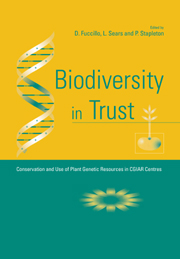Book contents
- Frontmatter
- Contents
- Preface
- Contributors
- Acronyms
- Chapter 1 Cassava
- Chapter 2 The Potato
- Chapter 3 Sweetpotato
- Chapter 4 Other Andean Roots and Tubers
- Chapter 5 Yams
- Chapter 6 Banana and Plantain
- Chapter 7 Cowpea
- Chapter 8 Chickpea
- Chapter 9 Groundnut
- Chapter 10 Lentil
- Chapter 11 Phaseolus Beans
- Chapter 12 Pigeonpea
- Chapter 13 Faba Bean
- Chapter 14 Soyabean
- Chapter 15 Barley
- Chapter 16 Maize, Tripsacum and Teosinte
- Chapter 17 Pearl Millet
- Chapter 18 Small Millets
- Chapter 19 Rice
- Chapter 20 Sorghum
- Chapter 21 Wheat
- Chapter 22 Forages
- Index
Chapter 19 - Rice
Published online by Cambridge University Press: 22 September 2009
- Frontmatter
- Contents
- Preface
- Contributors
- Acronyms
- Chapter 1 Cassava
- Chapter 2 The Potato
- Chapter 3 Sweetpotato
- Chapter 4 Other Andean Roots and Tubers
- Chapter 5 Yams
- Chapter 6 Banana and Plantain
- Chapter 7 Cowpea
- Chapter 8 Chickpea
- Chapter 9 Groundnut
- Chapter 10 Lentil
- Chapter 11 Phaseolus Beans
- Chapter 12 Pigeonpea
- Chapter 13 Faba Bean
- Chapter 14 Soyabean
- Chapter 15 Barley
- Chapter 16 Maize, Tripsacum and Teosinte
- Chapter 17 Pearl Millet
- Chapter 18 Small Millets
- Chapter 19 Rice
- Chapter 20 Sorghum
- Chapter 21 Wheat
- Chapter 22 Forages
- Index
Summary
Rice feeds half the world's people, mainly in Asia. Their food security and crop biodiversity depend upon continued access to seed developed from thousands of locally adapted varieties of Oryza sativa and O. glaberrima that Asian and African farmers have grown for generations, the more than 20 species of wild rice native to Asia, Africa, Latin America and Oceania, and the related genera in the tribe Oryzeae. Worldwide, about 80 million ha of rice are grown under irrigated conditions, the most important rice production system, with average yields of 3-9 t/ha. Athough four CGIAR centres (IRRI, WARDA, CIAT and IITA) hold and use rice germplasm, only IRRI has a global mandate to conserve and improve germplasm. Other centres have regional or continental mandates in Africa and Latin America.
The aggregate population of the less-developed countries grew from 2.3 billion in 1965 to 4.1 billion in 1991. Asia accounted for 59% of the global population, about 92% of the world's rice production and 90% of global rice consumption. Bangladesh, China, India, Indonesia, Myanmar, Thailand and Vietnam are the world's largest rice producers, accounting for about 78% of world production (IRRI 1995). Even with rice providing 35–80% of total calories consumed in Asia and with a slowing of growth in total planted area, production has so far kept up with demand. The world's annual rough rice production, however, will have to increase by almost 70% over the next 35 years to keep up with population growth and income-induced demand for food.
- Type
- Chapter
- Information
- Biodiversity in TrustConservation and Use of Plant Genetic Resources in CGIAR Centres, pp. 273 - 291Publisher: Cambridge University PressPrint publication year: 1997
- 3
- Cited by

